
Octopuses and squid belong to the order
Octopoda, which is in the class Cephalopods,
phylum Mollusca, which includes snails
and clams. They are related to other mollusks but
have no internal or external shell. There are more
than one thousand species of octopuses and squid
alive today. They have two eyes and eight (octopuses)
to ten (some squid) tentacles that are attached
directly to the head. The tentacles are covered
with sucker pads that help the animal move
along the ocean floor, its normal place of residence.
They have the most complex brain of the
invertebrates, and also have long- and short-term
memories, much like vertebrates.
The genus Octopus contains several different
species, which vary greatly in size. The smallest is
Octopus arborescens, a species that averages two
inches in length. The largest species, Octopus
dofleini, commonly known as the giant Pacific octopus,
can grow to sixteen feet in length and
weigh up to three hundred pounds, with a tentacle
span of thirty feet. The best known and most
widely distributed species is Octopus vulgaris, a
medium-sized octopus found in every ocean. This
species is fromtwo to three feet in length and lives
in holes on the ocean floor. It feeds mainly on
crabs, lobsters, and other crustaceans. It is very intelligent:
One Japanese scientist taught an octopus
how to open a sealed jar in order to get at its contents,
a spiny lobster.
An octopus can change its skin color quickly
when it is frightened or threatened. Its changed
color provides camouflage to help it blend in with
the background so that the octopus becomes almost
invisible to predators. Scientists have discovered
that octopuses change colors not only for
defense, but also to reveal their moods and emotions.
Angry members of the species turn a deep
red in color, while during mating season, both
males and females display stripes and colors that
reflect their inner excitement. Some species squirt
out clouds of a dark inky substance, which hangs
in the water for several seconds. This inkblot has
the same size and shape as the octopus, and while
it draws the attention of the predator, the octopus
escapes. When an enemy, such as a moray eel, attacks
an octopus, it may lose one of its eight arms
in the fight, and while the eel watches the twitching
arm the injured octopus can swim away. The
tentacle grows back very quickly.
Squid are cephalopods and belong to the order
Teuthoidea (ten-armed), which has many species.
They are found in every ocean and range in size
fromless than one inch to more than sixty-five feet
in length. Adult squid of some species can race
through the water at speeds of up to twenty-five
miles per hour. They are aggressive hunters,
equipped with two more tentacles than octopus.
The squid use these extra arms to catch their food.
Some squid hunt in packs and use their ability to
change color to lure their prey. They are also
bioluminescent, which means they can light up. Actually, bacteria living under their skin produce
the light in squid that live close to the surface.
Deep-water squid, on the other hand, living thousands
of feet below the surface, make their own
light. These species have light-producing organs
called photophores that make two chemicals: a
protein called luciferin and an enzyme known as
luciferase. When the two chemicals are mixed, the
enzyme breaks down the protein, releasing a pale,
blue-green light. This is the same process used by
fireflies. Some squid species can squirt out clouds
of glowing bacteria when they are endangered.
This light show distracts the predator and helps
the squid escape.
Squid, Cuttlefish, and Nautilus
The giant squid, Architeuthi, is the largest invertebrate
on the earth, having eyes the size of automobile
headlights and weighing up to one thousand
pounds. Despite their size, no one has ever seen
one of these animals in its natural environment.
Although these monsters of the deep have been
found in the nets of commercial fishermen, in the
stomachs of sperm whales, and washed ashore in
Australia, no scientific information has been gathered
on the species by direct observation. Perhaps
the major reason so little is known about giant
squid is that they live so deep in the ocean. Another
reason is their enormous speed and rapid
acceleration. Because of this speed they can easily
evade their major predators, tuna and sharks.
Some apparently even have the ability to leave the
water for short periods and glide through the air
like flying fish to escape their enemies.
The cuttlefish, genus Sepia, is a cephalopod that
can eject clouds of ink to confuse enemies and can
swim almost as rapidly as squid. It most remarkable
characteristic, however, is its ability to
change color, which biologists believe is used by
the species as a method of communication. Cuttlefish
can display thirty different color patterns that
range from very light to very dark. They can also
exhibit zebralike stripes and patterns that look
like a pair of dice. They can change colors quickly
to escape predators by blending into the background.
Color changes are also used to attract
mates and outshine rivals during courtship. Cuttlefish
have ten arms or tentacles, with two longer
than the other eight. Most of the time the two longer
arms are tucked under their bodies, but if supper
swims by they shoot out to grab the shrimp or
fish and drag it to their mouths.
Next to the octopus, the cuttlefish is probably
the most intelligent invertebrate in the sea. In experiments,
cuttlefish have been taught to recognize
which colored disks signal food and which
do not. Baby cuttlefish know from the moment of
birth how and when to bury themselves in the
sand, how to squirt an inky substance to confuse
predators, and how to get away quickly when
they encounter larger animals. The ink of the cuttlefish,
which is called sepia (the genus name) was
the original dark pigment used in India ink. This
ink was used in quill pens in England and France
in the 1600's and is still used today by artists for
drawing and lettering. The chambered nautilus is one of five species in
the genus Nautilus. It is a living fossil. The surviving
species are found only 60 to 1,500 feet below
the surface of the Indian and Pacific oceans. Five
hundred million years ago, nautiloids were the
masters of the sea. At that time there were more
than 2,500 species, some with straight shells and
others with coiled shells like the modern nautilus.
They are nocturnal feeders, coming to the surface
only on moonless nights to feast on small fish and
shrimp. They are the only members of the class
Cephalopoda to still have an external shell. They
have eighty to one hundred arms surrounding
their heads. Each arm can touch and taste food.
The nautilus gets itsnamefromthe thirty to thirtyeight
walled chambers that are found inside its
shell. The animal lives in the outermost chamber
and uses the others to float in the water.
The nautilus is an endangered species, mainly
because of the beauty of its shell. Philippine Island
fishermen catch about five thousand living animals
every year to sell to shell collectors. They are
also hunted extensively off the coasts of India and
Indonesia.
Growth and Reproduction
Most cephalopods, including the giant squid,
grow quickly and die after a short life. The great
Pacific octopus, for example, which is only onetwentieth
the size of the giant squid, lives just two
to three years. It is estimated that the giant squid
lives for no more than five years. This means that
its growth to adulthood is extremely fast. When it
is a baby, it is less than an inch long, but within
three years it has reached almost sixty feet in
length. Growing at such a rapid rate requires huge
amounts of food. Giant squid eat enormous quantities
of fish and other squid, which they catch
with the suckers on their tentacles and crush in
their massive mouths.
Octopuses and squid have separate sexes and
reproduce internally. In some species, modified
sucker discs at the tip of one of its tentacles distinguish
the male. This arm is used to remove a
packet of sperm from within his body cavity and
insert it into the cavity of the female. Within two
months after mating, the female attaches strands
of clustered eggs to the ceiling of her dwelling under
the sand. The number of eggs laid varies
greatly from species to species, with the common
octopus laying anywhere from 200,000 to 400,000
very tiny eggs. Other species lay as few as 150
eggs. Once the eggs are laid, the mother gently caresses
the eggs with her suckers to keep algae and
bacteria from growing on them. She also squirts
them with streams of water to keep them clean. As
the baby inside the egg matures, the mother's gentle
caresses become more violent to help the developing
octopus break away from its egg house.
Most mothers do not eat after laying their eggs
and die shortly after their eggs have hatched.
Baby octopuses in species like Octopus vulgaris are
carried about in water currents for about a month
before they settle to the bottom, where they start
to feed. Babies in other species look just like a miniature
adult and immediately sink to the bottom
where they start living. On average, the survival
rate for a baby octopus is extremely tiny. Only
about one or two out of 200,000 eggs will survive
to become an adult.
The chambered nautilus cements its eggs to
rocks or coral on the seafloor. They take almost a
year to hatch. A baby nautilus is only about an
inch long when it hatches from its egg case but
grows into an adult quickly. It is the longest-living
cephalopod, with some adults living fifteen to
twenty years. Unlike the octopus, the chambered
nautilus does not die immediately after reproduction.
Cephalopods make up a large part of the diet of
whales, seals, fishes, and seabirds.
Cephalopod Evolution
The earliest ancestors of octopuses and squid
were mollusks with thick shells that protected
them from their enemies. Of the estimated one
thousand species of cephalopods still living, only
the chambered nautilus and cuttlefish have remnants
of an internal shell. Cephalopods began losing
their shells in the Triassic period, 245 to 208
million years ago. The earliest squid appeared in
the Jurassic period, 208 to 144 million years ago.
The oldest known octopod, Palaeoctopus newboldi,
now extinct, comes from the Cretaceous period
and is at least 140 million years old.
Octopuses and squid Facts
Classification:
Kingdom: Animalia
Subkingdom: Eumetazoa
Phylum: Mollusca
Class: Cephalopoda
Subclass: Nautiloidea (chambered nautilus),
Coleoidea (octopuses and squid)
Orders: Sepioidea (cuttlefishes), Teuthoidea
(squid), Octopoda (octopuses)
Suborder: Three suborders of Octopoda-Palaeoctopoda
(finned), Cirrata (webbed), Incirrata
(round bodied)
Geographical location: Every ocean, but mainly
the Indian Ocean and the South Pacific
Habitat: The ocean floor
Gestational period: Varies by species from forty
days to one year
Life span: One to three years for octopuses; five
years for squid; fifteen to twenty years for
chambered nautilus
Special anatomy: Eight to ten tentacles, usually
with suction cups at the end; round, sacklike
bodies for octopuses
Other popular Animals
Photo Gallery of - Octopuses and squid
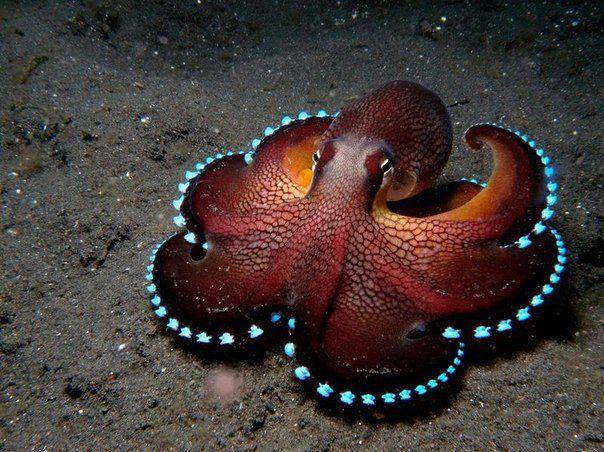


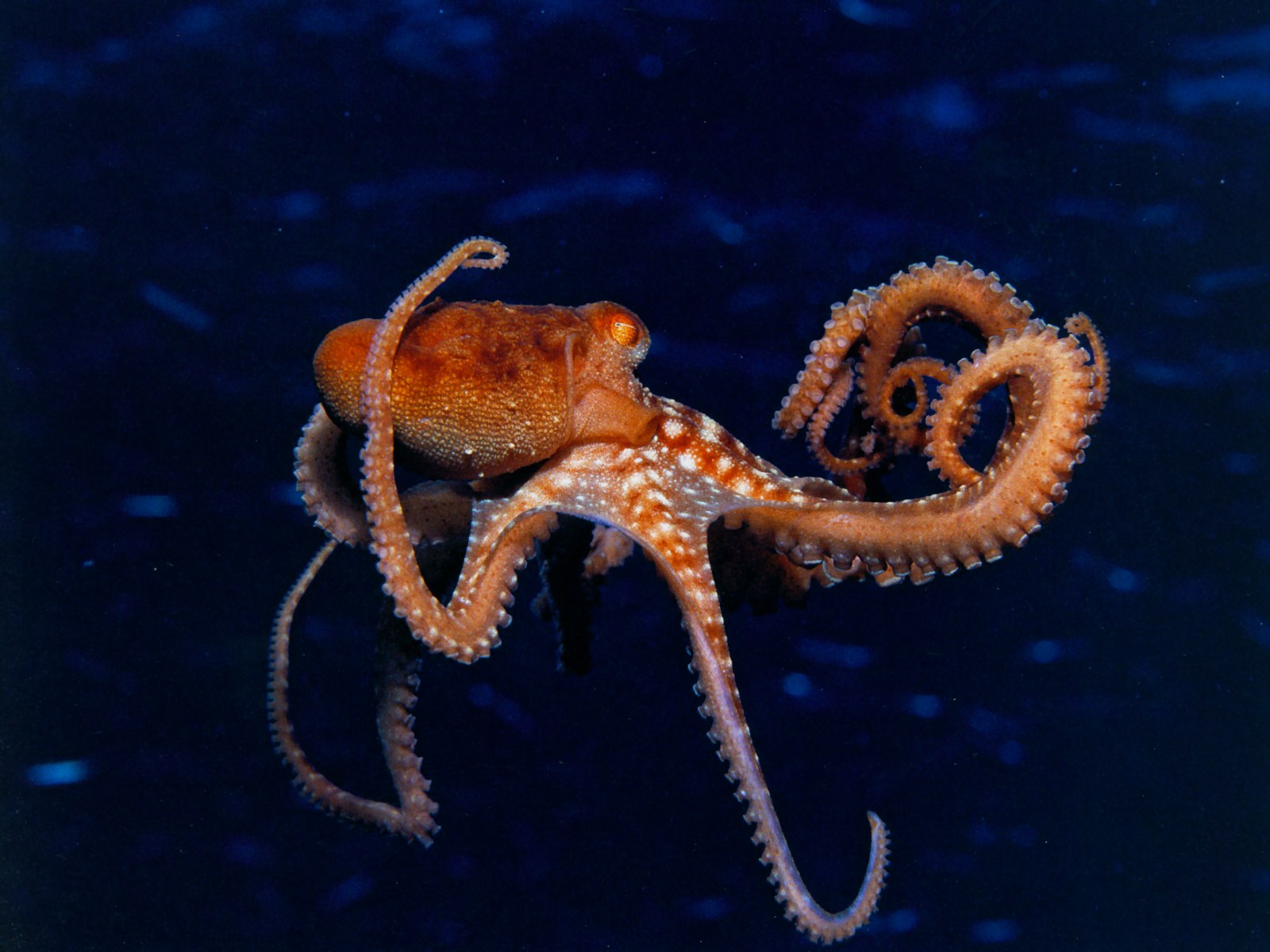
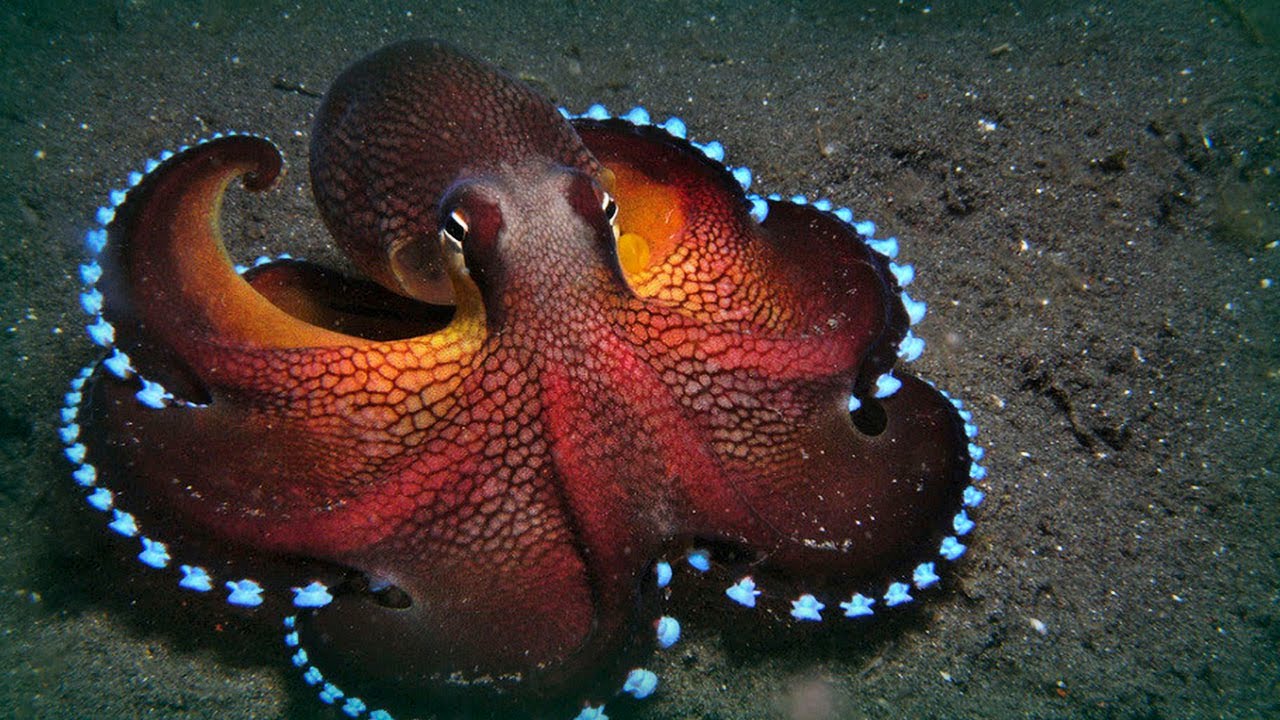
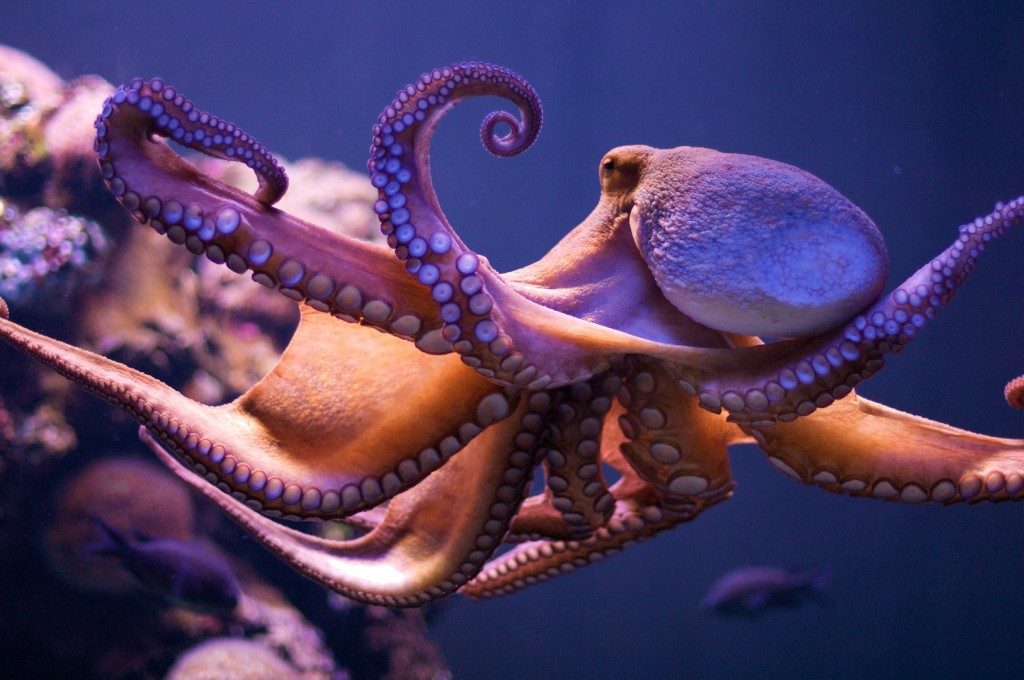
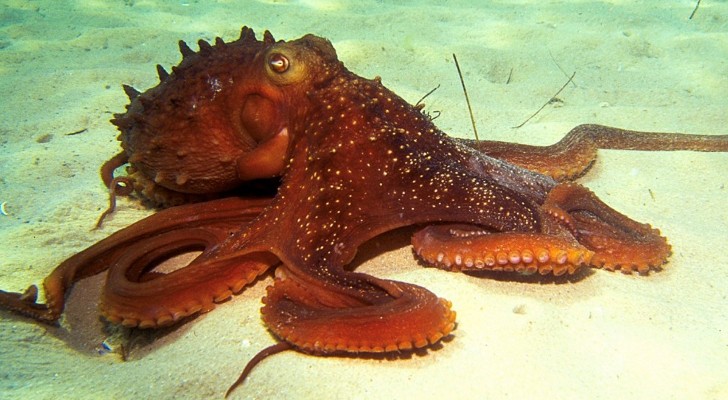

 Animalia Life
Animalia Life